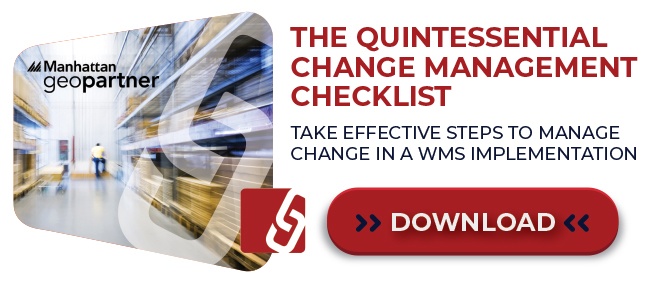WMS TRAINING for Implementation Triumph: How it works


Team training is a key element in a successful warehouse implementation. Even the best system in the world cannot operate without being run! In this blog we speak to William Sudding, tech trainer supreme at Supply Chain Junction, to tell you everything you need to know about the training that should happen before your business is ready to rock your new systems.
WHY DO YOU NEED WMS TRAINING?
Basically, your staff need to run your own system, and the better they know and understand it, the better it will operate. If you need to get an outside consultant in constantly it will not only slow down your supply chain as you troubleshoot, but it will cost you enormously.
The better the team training, and the better your team, the smoother your implementation will be and the quicker you will start to experience an ROI on your investment and optimise staff satisfaction and support.
WHAT DOES WMS TRAINING COVER?
Staff training on your Warehouse Management Systems / Order Management Systems from your vendor should cover all actions and tech functions around the warehouse processes, broken up by area. As your vendors are intimate and familiar with these systems, this will save valuable time by explaining the correct procedures and processes. SCJ also offers an optional Standard Operational Procedures per role and area, drawn up by us.
Each training process is custom designed for the specific business in which we implement. General functionality training is standard, but variation in outbound, inbound, and specific processes will vary based on the business' functional requirements.
Bear in mind that complex warehouse processes require more training, especially when looking at scenario-based training and education around different outcomes or inputs.
WMS TRAINING SEGMENTS
Training is divided up into the following segments for maximum efficiency:
-
Train the trainer
- we do supervisor training to create a “superuser” per area (inbound/outbound /picking etc) who can then take their new knowledge and train their staff.
OR if the business doesn't feel that they have the capacity to train their staff, SCJ will do superuser training and then roll out functional training to the floor personnel, with lessons broken up by role.
-
General training
is usually limited to warehouse personnel only.
-
Management overview training
is provided for those who need to understand the functionalities and inputs and use data effectively, but who do not use the software on a day-to-day basis.
Any other personnel who would like to be informed and included can join a superuser training group. Upscaling staff is a great way of keeping them motivated and invested, and eventually creating an opportunity for career growth within your business.
WMS TRAINING PRESENTATION:
We use classroom-style lectures with presentations and demos, which can also be done remotely. All hands-on training required (such as for floor staff) must be done in person, and during these times we are extremely strict about Covid compliance.
In our training sessions we create a "playpen" as a demo of the system, with the equipment labelled and laid out, linked to the software ready for on-the-job training and familiarisation, so there is no risk to the actual system and stock.
WHEN SHOULD WMS TRAINING HAPPEN?
Either during testing of the final system design - once the system is signed off and all functionality is finalised - or after testing, when everything is in the final stages of tweaks.
HOW LONG DOES IT TAKE?
Operational requirements of each business as well as the chosen system will dictate the length of training - the more complex the system, the more intricacies, functions, and troubleshooting we need to incorporate into staff education.
Usually, superuser training takes a few days, but with an operational business, the groups will be smaller and the training will be more spread out.
Warehouse staff training takes a few hours, but again, no operational business can spare all their staff in one day, so we recommend smaller groups who repeat the training protocol until everyone has been through the training.
TRAINING CHALLENGES THE CLIENT CAN SOLVE
To save time and money, there are several aspects we recommend having in place before we begin.
Computer literacy is the greatest barrier in the WMS onboarding process, so either staff should be selected based on their familiarity with digital technology, or basic training should be provided independently until they are comfortable with basics. This is a worthwhile investment for any company, as it will ultimately benefit them on several fronts.
The technological maturity of the business and its employees dictates how much input will be required in terms of tech understanding before actual training takes place. This lack of maturity manifests as:
- fear of using the system in case it breaks
- an unwillingness to try the scanning / picking / etc processes.
Readiness must be assessed and ensured before training begins. If you are not sure how to do that, Supply Chain Junction will consult with the change management team to assess and discuss readiness. Remember - change management and training go hand in hand.
TRAINING CHALLENGES
There are several staff issues that can arise that can affect the length and success of training, including:
- Attendance
- Attention
- Resistance to change
These problems usually stem from the company not managing the change effectively, and neglecting to get buy in from their impacted staff. Staff must understand that they will be supported throughout the change, and understand the benefits of committing to the change of system.
READINESS AND ASSESSMENT FOR TRAINING
Before training, we will make recommendations about how to select your teams, members, who you need and why. Having the correct players in each sector is essential for the ultimate success of the entire training and as a follow on, your system implementation.
After training, SCJ assesses the skills that have been gained and analyse the suitability of your staff to continue in the new role assigned. Comfort with the system and capability to use effectively are checked and monitored - we call this our Key Roles Assessment, where your project team's capability and the superuser competence are graded.
Don't worry if there is no change management plan in place, no competent project team selected, or a very low technological maturity; SCJ will work with your business to put these in place.
SCJ’S TOP 5 INSIDER TIPS FOR SUCCESSFUL TRAINING:
- Train when the system is 95% correct so by the time it is ready, your staff are too.
- Be ready - especially with data!
- Make sure staff are willing and understand what is required of them.
- Express functional requirements and operational limitations upfront so that the correct timelines, training, and inputs can be provided.
- Plan to have your staff rotate on the training schedule.
To see your own specific training road map and list out your requirements and likely plan of action, consult with SCJ.
Alternatively, continue your research on managing change by downloading our change management checklist:
TAGS
- WMS (50)
- Warehouse Best Practice (46)
- Implementing a WMS (29)
- Managing your warehouse (19)
- Omni Channel (18)
- eCommerce (18)
- Blog (16)
- Supply Chain Best Practice (16)
- Mid-Level (8)
- Customer Journey (7)
- Warehouse optimisation (7)
- General Tips (5)
- Industry General (5)
- Information (5)
- managing your Supply Chain (5)
- saudi arabia (5)
- Trends (4)
- smart warehouse (4)
- 3PL (3)
- News (3)
- ERP (2)
- Entry-level (2)
- ROI (2)
- Case Study (1)
- OMS (1)
- Picking (1)
- Press Release (1)
- Solution-Specific (1)
- Transport Management System (1)
Take A Look At The Results Of A Successful WMS Implementation.
See how Tarsus Distribution, in collaboration with SCJ boost overall efficiency by 60%




